

Stéphane Chaudiron. Madjid Ihadjadene. Re-questionner les pratiques informationnelles. 1Le concept de « pratique informationnelle » semble de plus en plus employé dans le domaine scientifique de l’information communication, que ce soit pour désigner ce que les acteurs font avec l’information – qu’elle soit professionnelle, scientifique, culturelle – ou pour signifier la manière dont ils utilisent les dispositifs techniques intermédiaires.
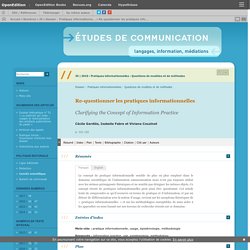
Or, ce concept n’est pas toujours utilisé avec les mêmes présupposés théoriques et ne semble pas désigner les mêmes objets. Pourtant « la vertu théorique des concepts ne réside pas dans le système de termes qu’ils stabilisent mais dans le travail de description et de mesure qu’ils imposent » (Granjon, 2002). L’étude d’un objet scientifique est liée à la posture épistémologique retenue (théorie, concepts) et à la méthode employée (Fondin, 2001). 2Qu’en est-il pour ce concept récent de « pratique informationnelle » ? 3Le terme « pratique » vient du verbe grec prattein signifiant « agir » qui donne praxis, « action ». 4Pour P. 6Pour J. Evolutions technologiques et information professionnelle : pratiques, acteurs et documents.
Marcia Bates. Information-Seeking Models. Researchers have been interested in how human beings actively search and retrieve information resources for many years.

Various information-seeking models have been developed over the years to help explain this phenomena. These researchers include Dervin, Ellis, and Kuhlthau. Marcia Bates defined information behavior as ” a term to describe the many ways in which human beings interact with information, in particular, the ways in which people seek and utilize information. Brenda Dervin developed the Sense-making Model (1980s/1990s) which was conceptualized as a gap-bridging process in which the user makes a decision, influenced by information to reach their ultimate outcome or goal. David Ellis (1989, 2005) developed a information-seeking model that was built on eight different features/stages information seekers move through when completing a search. Resources Kuhlthau, C.C. (2010) Information Search Process (ISP) Model.
Information seeking research needs extension towards tasks and technology. Kalervo Järvelin Department of Information Studies Tampere University, Tampere, Finland Peter Ingwersen The Royal School of Librarianship and Information Science Copenhagen, Denmark Abstract This paper discusses the research into information seeking and its directions at a general level.
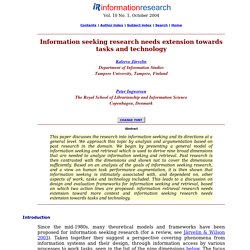
We approach this topic by analysis and argumentation based on past research in the domain. La résistance aux systèmes d'information. A COMPARISON OF THE INFORMATION SEEKING PATTERNS OF RESEARCHERS IN THE PHYSICAL AND SOCIAL SCIENCES: Journal of Documentation: Vol 49, No 4. Author(s): DAVID ELLIS (Department of Information Studies University of Sheffield, Regent Court, 211 Portobello, Sheffield SI 4DP) DEBORAH COX (Department of Information Studies University of Sheffield, Regent Court, 211 Portobello, Sheffield SI 4DP) KATHERINE HALL (Department of Information Studies University of Sheffield, Regent Court, 211 Portobello, Sheffield SI 4DP) Citation:
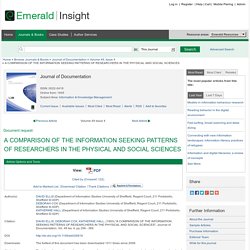
Financial Times. Cognitive needs are draped in affective responses so that they are as much felt as they are thought about.
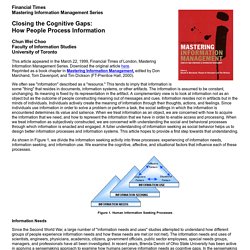
When sense has run out, the lack of understanding creates a state of uncertainty. Carol Kuhlthau of Rutgers University found that uncertainty causes a number of affective symptoms, including anxiety, apprehension, confusion, frustration, and lack of confidence. These affective states motivate and direct the individual’s information seeking and information use experience. Affective responses influence, and are influenced by, the individual’s ability to construct meaning, focus information needs, manage moods and expectations, and deepen personal interest in the search. Tom Wilson of Sheffield University suggests that uncertainty and its affective symptoms can constitute a state of stress that the individual has to cope with.
At the situational level, information needs arise from the problems, uncertainties, and ambiguities encountered in specific contexts and experiences. A Behavioral-Ecological Framework for Intranet Design. ASIS 96: Structure and Action. No.
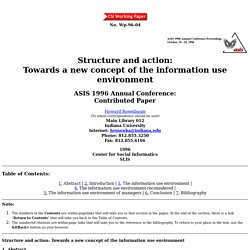
Wp-96-04 Howard Rosenbaum(To whom correspondence should be sent)Main Library 012Indiana UniversityInternet: hrosenba@indiana.eduPhone: 812.855.3250Fax: 812.855.6166 1996Center for Social InformaticsSLIS Table of Contents: 1. Note:The numbers in the Contents are within-pagelinks that will take you to that section in the paper. Structure and action: Towards a new concept of the information use environment. Structure and Action: Towards a New Concept of the Information Use Environment. L'adéquation entre le système d'information et la veille stratégique dans une activité de construction de sens. Dans quelle mesure le système d’information actuel incarne en lui cette capacité d’absorber les informations de veille stratégique ?
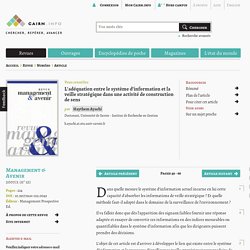
Et quelle méthode faut-il adopté dans le domaine de la surveillance de l’environnement ? Il va falloir donc que dès l’apparition des signaux faibles fournir une réponse adaptée et essayer de convertir ces informations en des indices mesurables ou quantifiables dans le système d’information afin que les dirigeants puissent prendre des décisions.
Bernard Miège : L’information-communication, objet de connaissance. 1Comment lire ce livre de Bernard Miège ?
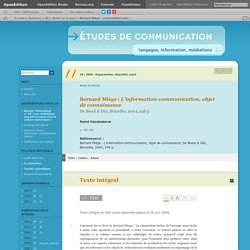
La composition même de l’ouvrage nous invite à poser cette question en préambule à notre recension. Le lecteur pourra en effet se reporter à ce volume comme à une anthologie de textes, puisqu’il s’agit bien du regroupement de 19 contributions distinctes, pour l’essentiel déjà publiées entre 1984 et 2004. Les espaces éditoriaux et les contextes de production des textes originaux ainsi que les références à des objets de recherches en évolution conduisent au séquençage de la somme.